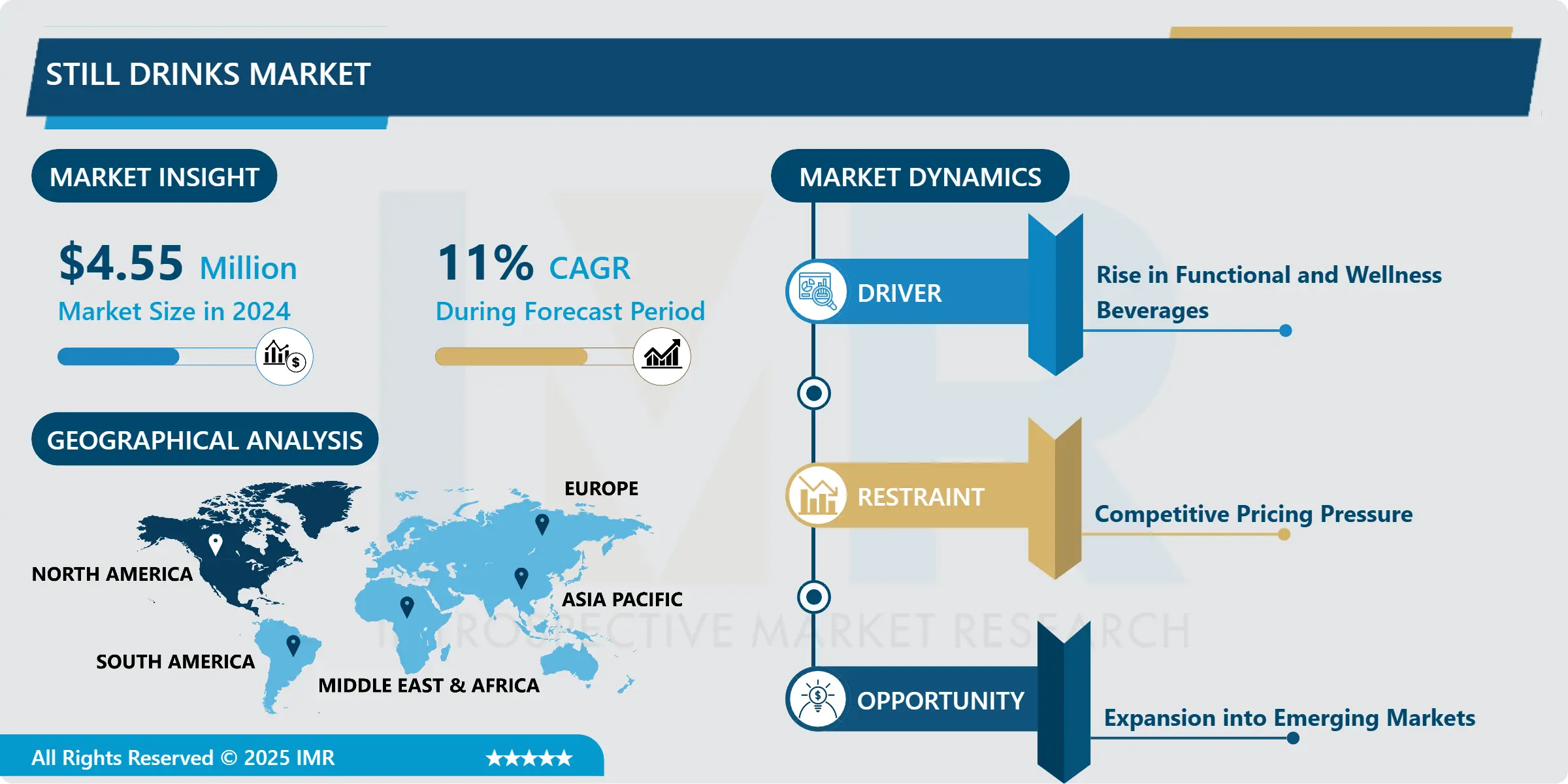Still Drinks Market Synopsis
Still Drinks Market Size Was Valued at USD 4.55 Million in 2024, and is Projected to Reach USD 10.49 Million by 2032, Growing at a CAGR of 11.00% From 2025-2032.
Still drinks refer to non-carbonated beverages that do not contain alcohol. These beverages are typically flavored water-based drinks that may contain fruit juices, sweeteners, and sometimes vitamins or minerals. They are consumed chilled and are popular as refreshing beverages in various flavors such as fruit punch, lemonade, and iced tea.
The still drinks market represents a dynamic segment within the broader beverage industry, characterized by its non-carbonated nature and diverse range of flavors and functional benefits. This market encompasses a variety of products such as fruit juices, iced tea, flavored water, sports and energy drinks, and ready-to-drink (RTD) coffee and tea, catering to different consumer preferences and lifestyles.
The still drinks market has experienced significant growth driven by several key factors. Firstly, increasing consumer awareness and preference for healthier beverage options have fueled demand for still drinks over carbonated alternatives. Health-conscious consumers are seeking beverages that offer natural ingredients, reduced sugar content, and functional benefits such as vitamins, antioxidants, and hydration properties.
Secondly, changing lifestyles and urbanization have contributed to the popularity of convenient, on-the-go beverage solutions. Ready-to-drink formats and single-serve packaging have become increasingly prevalent, catering to busy lifestyles where convenience and portability are paramount.
Furthermore, innovation in flavor profiles and product formulations has played a crucial role in expanding the still drinks market. Manufacturers are continuously introducing new flavors, botanical infusions, and novel ingredients to appeal to diverse consumer tastes and preferences. This innovation extends to product differentiation through organic, natural, and sustainable sourcing practices, aligning with growing consumer demand for environmentally responsible products.
Geographically, the still drinks market exhibits varying trends and consumption patterns across regions. In developed markets such as North America and Europe, demand is driven by health-conscious consumers seeking low-calorie, natural alternatives to sugary beverages. The emphasis on clean-label products and transparency in ingredients sourcing has further shaped consumer preferences in these regions.
In emerging markets such as Asia-Pacific, Latin America, and parts of Africa, rising disposable incomes, urbanization, and expanding retail infrastructure are driving growth in the still drinks market. Consumers in these regions are increasingly adopting westernized dietary habits and are attracted to the perceived health benefits and convenience offered by still drinks.
Despite the positive growth trajectory, the still drinks market faces challenges such as regulatory pressures, particularly concerning sugar content and labeling requirements. Moreover, competitive pricing dynamics and the need for continuous innovation pose challenges for market players aiming to differentiate their products in a crowded marketplace.
However, the market presents significant opportunities for growth through strategic partnerships, mergers and acquisitions, and investments in research and development. Expansion into untapped geographical markets and leveraging digital marketing channels to engage with tech-savvy consumers are also avenues for market players to explore.
In conclusion, the still drinks market is poised for continued growth driven by shifting consumer preferences towards healthier, functional beverages. Innovation, diversification of product offerings, and adaptation to regional tastes and regulatory landscapes will be critical for stakeholders aiming to capitalize on the evolving market dynamics and emerging opportunities in the global beverage industry.


Still Drinks Market Trend Analysis
Still Drinks Market Growth Drivers- Rise in Functional and Wellness Beverages
- The functional and wellness beverages market, particularly still drinks, has experienced a significant rise driven by shifting consumer preferences towards healthier alternatives. Consumers are increasingly seeking beverages that offer functional benefits such as hydration, added vitamins, minerals, and natural ingredients promoting well-being. This trend is fueled by rising health consciousness and concerns over sugar intake, prompting a demand for low-calorie and sugar-free options in the beverage sector. Key players in the market are responding by innovating with new product formulations that cater to specific health needs, such as immune support, digestive health, and stress reduction.
- Additionally, advancements in beverage technology and packaging have enabled the development of more appealing and convenient products, further boosting market growth. Geographically, North America and Europe are prominent markets due to their high consumer awareness and disposable income levels, while Asia-Pacific is emerging as a lucrative region driven by urbanization and increasing adoption of healthier lifestyles. Overall, the functional and wellness still drinks market is poised for continued expansion as companies continue to invest in research and development and respond to evolving consumer preferences globally.
Still Drinks Market Opportunities- Expansion into Emerging Markets
- Expansion into emerging markets in the still drinks market presents both opportunities and challenges for companies. On one hand, these markets often exhibit rapid economic growth and a rising middle class, creating a larger consumer base with increasing disposable income. This demographic shift can significantly boost demand for still drinks, driven by preferences for healthier beverage options and convenience. Moreover, entering these markets early allows companies to establish strong brand presence and loyalty before competitors.
- However, the challenges include navigating diverse regulatory environments, adapting products to local tastes and preferences, and building efficient distribution networks in often fragmented markets. Cultural differences and varying levels of market maturity also require tailored marketing strategies and operational adjustments. Successful expansion hinges on a robust understanding of local market dynamics, strategic partnerships with local distributors or retailers, and agility in responding to evolving consumer trends and competitive pressures.
Still Drinks Market Segment Analysis:
Still Drinks Market is Segmented based on Product Type, Flavor, and Distribution Channel .
By Product Type, Online Casino Gaming segment is expected to dominate the market during the forecast period
- In the still drinks market, segmentation by product type reveals a diverse landscape catering to various consumer preferences. Fruit juices represent a significant segment, appealing to health-conscious consumers seeking natural refreshment and nutritional benefits. Bottled water, often infused with flavors or enhanced with vitamins, targets hydration seekers looking for convenient and functional beverages. Energy drinks, known for their caffeine and stimulant content, appeal to consumers seeking quick energy boosts. Sports drinks, formulated with electrolytes, target athletes and active individuals needing hydration during or after physical activities.
- Ready-to-drink teas and coffees offer a convenient alternative to hot beverages, appealing to on-the-go consumers and those looking for specific flavor profiles and caffeine content. Functional drinks, which include beverages with added nutrients or health-promoting ingredients like probiotics or antioxidants, cater to consumers seeking beverages that support specific health goals. This segmentation underscores the diversity in consumer preferences and needs within the still drinks market, driving innovation and competition among manufacturers to meet varying demands effectively.
By Falvor , Lemon segment held the largest share in 2024
- The still drinks market segmented by flavor reveals varying consumer preferences and market dynamics across different regions. Chocolate-flavored still drinks appeal predominantly to markets where indulgent flavors are favored, often found in North America and parts of Europe where there is a strong consumer base for sweetened beverages with rich flavors. Mango-flavored drinks dominate in tropical regions such as Southeast Asia, India, and parts of South America, reflecting local fruit preferences and a preference for refreshing, fruity beverages. Lemon-flavored drinks are popular globally, prized for their tangy and refreshing taste, particularly in regions with hot climates where consumers seek thirst-quenching options.
- Mint-flavored drinks cater to markets valuing herbal and cooling flavors, often seen in Middle Eastern and Mediterranean regions. The "Others" category encompasses a diverse range of flavors like berry, apple, and tropical blends, catering to niche markets or specific consumer tastes. Overall, the by-flavor analysis of the still drinks market underscores the importance of regional preferences and cultural influences in shaping product demand and market growth strategies for beverage manufacturers.
Still Drinks Market Regional Insights:
North America is Expected to Dominate the Market Over the Forecast period
- The North America still drinks market is poised for substantial growth over the forecast period, driven by increasing consumer demand for healthier beverage options and innovative product offerings. Factors such as rising health consciousness among consumers, preference for low-calorie and natural beverages, and the expansion of distribution channels are key drivers shaping this market's trajectory. Major market players are focusing on launching new products with natural ingredients, reduced sugar content, and functional benefits to cater to evolving consumer preferences.
- Additionally, strategic mergers, acquisitions, and partnerships are enhancing market competitiveness and expanding regional market presence. Government initiatives promoting healthy lifestyles and sustainable consumption further bolster market growth. However, challenges such as fluctuating raw material prices and stringent regulations on labeling and product claims could potentially hinder market expansion. Overall, North America is expected to maintain its dominant position in the still drinks market, supported by robust consumer demand, innovation in product development, and strategic industry initiatives aimed at market expansion and sustainability..
Active Key Players in the Still Drinks Market
- The Coca-Cola Company (USA)
- PepsiCo, Inc. (USA)
- Nestlé S.A. (Switzerland)
- Danone S.A. (France)
- Keurig Dr Pepper Inc. (USA)
- Unilever N.V. (Netherlands)
- The Kraft Heinz Company (USA)
- Ocean Spray Cranberries, Inc. (USA)
- Suntory Holdings Limited (Japan)
- Campbell Soup Company (USA)
- Other Active Players
Still Drinks Market Scope:
|
Still Drinks Market |
|||
|
Base Year: |
2024 |
Forecast Period: |
2025-2032 |
|
Historical Data: |
2018 to 2023 |
Market Size in 2024: |
USD 4.55 Mn. |
|
Forecast Period 2024-32 CAGR: |
11.00% |
Market Size in 2032: |
USD 10.49 Mn. |
|
Segments Covered: |
By ProductType |
|
|
|
By Flavor |
|
||
|
By Distribution Channel |
|
||
|
By Region |
|
||
|
Key Market Drivers: |
|
||
|
Key Market Restraints: |
|
||
|
Key Opportunities: |
|
||
|
Companies Covered in the report: |
|
||
Chapter 1: Introduction
1.1 Scope and Coverage
Chapter 2:Executive Summary
Chapter 3: Market Landscape
3.1 Market Dynamics
3.1.1 Drivers
3.1.2 Restraints
3.1.3 Opportunities
3.1.4 Challenges
3.2 Market Trend Analysis
3.3 PESTLE Analysis
3.4 Porter's Five Forces Analysis
3.5 Industry Value Chain Analysis
3.6 Ecosystem
3.7 Regulatory Landscape
3.8 Price Trend Analysis
3.9 Patent Analysis
3.10 Technology Evolution
3.11 Investment Pockets
3.12 Import-Export Analysis
Chapter 4: Still Drinks Market by ProductType (2018-2032)
4.1 Still Drinks Market Snapshot and Growth Engine
4.2 Market Overview
4.3 Fruit Juice
4.3.1 Introduction and Market Overview
4.3.2 Historic and Forecasted Market Size in Value USD and Volume Units
4.3.3 Key Market Trends, Growth Factors, and Opportunities
4.3.4 Geographic Segmentation Analysis
4.4 Bottled Water Energy
4.5 Sports Drink
4.6 Ready to drink tea and coffee
4.7 functional drinks
Chapter 5: Still Drinks Market by Flavor (2018-2032)
5.1 Still Drinks Market Snapshot and Growth Engine
5.2 Market Overview
5.3 Chocolate
5.3.1 Introduction and Market Overview
5.3.2 Historic and Forecasted Market Size in Value USD and Volume Units
5.3.3 Key Market Trends, Growth Factors, and Opportunities
5.3.4 Geographic Segmentation Analysis
5.4 Mango
5.5 Lemon
5.6 Mint
5.7 Others
Chapter 6: Still Drinks Market by Distribution Channel (2018-2032)
6.1 Still Drinks Market Snapshot and Growth Engine
6.2 Market Overview
6.3 Hypermarkets and Supermarkets
6.3.1 Introduction and Market Overview
6.3.2 Historic and Forecasted Market Size in Value USD and Volume Units
6.3.3 Key Market Trends, Growth Factors, and Opportunities
6.3.4 Geographic Segmentation Analysis
6.4 Online Stores
6.5 Convenience Stores
Chapter 7: Company Profiles and Competitive Analysis
7.1 Competitive Landscape
7.1.1 Competitive Benchmarking
7.1.2 Still Drinks Market Share by Manufacturer (2024)
7.1.3 Industry BCG Matrix
7.1.4 Heat Map Analysis
7.1.5 Mergers and Acquisitions
7.2 THE COCA-COLA COMPANY (USA)
7.2.1 Company Overview
7.2.2 Key Executives
7.2.3 Company Snapshot
7.2.4 Role of the Company in the Market
7.2.5 Sustainability and Social Responsibility
7.2.6 Operating Business Segments
7.2.7 Product Portfolio
7.2.8 Business Performance
7.2.9 Key Strategic Moves and Recent Developments
7.2.10 SWOT Analysis
7.3 PEPSICO INC. (USA)
7.4 NESTLÉ S.A. (SWITZERLAND)
7.5 DANONE S.A. (FRANCE)
7.6 KEURIG DR PEPPER INC. (USA)
7.7 UNILEVER N.V. (NETHERLANDS)
7.8 THE KRAFT HEINZ COMPANY (USA)
7.9 OCEAN SPRAY CRANBERRIES INC. (USA)
7.10 SUNTORY HOLDINGS LIMITED (JAPAN)
7.11 CAMPBELL SOUP COMPANY (USA)
7.12 OTHER KEY PLAYERS
7.13
Chapter 8: Global Still Drinks Market By Region
8.1 Overview
8.2. North America Still Drinks Market
8.2.1 Key Market Trends, Growth Factors and Opportunities
8.2.2 Top Key Companies
8.2.3 Historic and Forecasted Market Size by Segments
8.2.4 Historic and Forecasted Market Size by ProductType
8.2.4.1 Fruit Juice
8.2.4.2 Bottled Water Energy
8.2.4.3 Sports Drink
8.2.4.4 Ready to drink tea and coffee
8.2.4.5 functional drinks
8.2.5 Historic and Forecasted Market Size by Flavor
8.2.5.1 Chocolate
8.2.5.2 Mango
8.2.5.3 Lemon
8.2.5.4 Mint
8.2.5.5 Others
8.2.6 Historic and Forecasted Market Size by Distribution Channel
8.2.6.1 Hypermarkets and Supermarkets
8.2.6.2 Online Stores
8.2.6.3 Convenience Stores
8.2.7 Historic and Forecast Market Size by Country
8.2.7.1 US
8.2.7.2 Canada
8.2.7.3 Mexico
8.3. Eastern Europe Still Drinks Market
8.3.1 Key Market Trends, Growth Factors and Opportunities
8.3.2 Top Key Companies
8.3.3 Historic and Forecasted Market Size by Segments
8.3.4 Historic and Forecasted Market Size by ProductType
8.3.4.1 Fruit Juice
8.3.4.2 Bottled Water Energy
8.3.4.3 Sports Drink
8.3.4.4 Ready to drink tea and coffee
8.3.4.5 functional drinks
8.3.5 Historic and Forecasted Market Size by Flavor
8.3.5.1 Chocolate
8.3.5.2 Mango
8.3.5.3 Lemon
8.3.5.4 Mint
8.3.5.5 Others
8.3.6 Historic and Forecasted Market Size by Distribution Channel
8.3.6.1 Hypermarkets and Supermarkets
8.3.6.2 Online Stores
8.3.6.3 Convenience Stores
8.3.7 Historic and Forecast Market Size by Country
8.3.7.1 Russia
8.3.7.2 Bulgaria
8.3.7.3 The Czech Republic
8.3.7.4 Hungary
8.3.7.5 Poland
8.3.7.6 Romania
8.3.7.7 Rest of Eastern Europe
8.4. Western Europe Still Drinks Market
8.4.1 Key Market Trends, Growth Factors and Opportunities
8.4.2 Top Key Companies
8.4.3 Historic and Forecasted Market Size by Segments
8.4.4 Historic and Forecasted Market Size by ProductType
8.4.4.1 Fruit Juice
8.4.4.2 Bottled Water Energy
8.4.4.3 Sports Drink
8.4.4.4 Ready to drink tea and coffee
8.4.4.5 functional drinks
8.4.5 Historic and Forecasted Market Size by Flavor
8.4.5.1 Chocolate
8.4.5.2 Mango
8.4.5.3 Lemon
8.4.5.4 Mint
8.4.5.5 Others
8.4.6 Historic and Forecasted Market Size by Distribution Channel
8.4.6.1 Hypermarkets and Supermarkets
8.4.6.2 Online Stores
8.4.6.3 Convenience Stores
8.4.7 Historic and Forecast Market Size by Country
8.4.7.1 Germany
8.4.7.2 UK
8.4.7.3 France
8.4.7.4 The Netherlands
8.4.7.5 Italy
8.4.7.6 Spain
8.4.7.7 Rest of Western Europe
8.5. Asia Pacific Still Drinks Market
8.5.1 Key Market Trends, Growth Factors and Opportunities
8.5.2 Top Key Companies
8.5.3 Historic and Forecasted Market Size by Segments
8.5.4 Historic and Forecasted Market Size by ProductType
8.5.4.1 Fruit Juice
8.5.4.2 Bottled Water Energy
8.5.4.3 Sports Drink
8.5.4.4 Ready to drink tea and coffee
8.5.4.5 functional drinks
8.5.5 Historic and Forecasted Market Size by Flavor
8.5.5.1 Chocolate
8.5.5.2 Mango
8.5.5.3 Lemon
8.5.5.4 Mint
8.5.5.5 Others
8.5.6 Historic and Forecasted Market Size by Distribution Channel
8.5.6.1 Hypermarkets and Supermarkets
8.5.6.2 Online Stores
8.5.6.3 Convenience Stores
8.5.7 Historic and Forecast Market Size by Country
8.5.7.1 China
8.5.7.2 India
8.5.7.3 Japan
8.5.7.4 South Korea
8.5.7.5 Malaysia
8.5.7.6 Thailand
8.5.7.7 Vietnam
8.5.7.8 The Philippines
8.5.7.9 Australia
8.5.7.10 New Zealand
8.5.7.11 Rest of APAC
8.6. Middle East & Africa Still Drinks Market
8.6.1 Key Market Trends, Growth Factors and Opportunities
8.6.2 Top Key Companies
8.6.3 Historic and Forecasted Market Size by Segments
8.6.4 Historic and Forecasted Market Size by ProductType
8.6.4.1 Fruit Juice
8.6.4.2 Bottled Water Energy
8.6.4.3 Sports Drink
8.6.4.4 Ready to drink tea and coffee
8.6.4.5 functional drinks
8.6.5 Historic and Forecasted Market Size by Flavor
8.6.5.1 Chocolate
8.6.5.2 Mango
8.6.5.3 Lemon
8.6.5.4 Mint
8.6.5.5 Others
8.6.6 Historic and Forecasted Market Size by Distribution Channel
8.6.6.1 Hypermarkets and Supermarkets
8.6.6.2 Online Stores
8.6.6.3 Convenience Stores
8.6.7 Historic and Forecast Market Size by Country
8.6.7.1 Turkiye
8.6.7.2 Bahrain
8.6.7.3 Kuwait
8.6.7.4 Saudi Arabia
8.6.7.5 Qatar
8.6.7.6 UAE
8.6.7.7 Israel
8.6.7.8 South Africa
8.7. South America Still Drinks Market
8.7.1 Key Market Trends, Growth Factors and Opportunities
8.7.2 Top Key Companies
8.7.3 Historic and Forecasted Market Size by Segments
8.7.4 Historic and Forecasted Market Size by ProductType
8.7.4.1 Fruit Juice
8.7.4.2 Bottled Water Energy
8.7.4.3 Sports Drink
8.7.4.4 Ready to drink tea and coffee
8.7.4.5 functional drinks
8.7.5 Historic and Forecasted Market Size by Flavor
8.7.5.1 Chocolate
8.7.5.2 Mango
8.7.5.3 Lemon
8.7.5.4 Mint
8.7.5.5 Others
8.7.6 Historic and Forecasted Market Size by Distribution Channel
8.7.6.1 Hypermarkets and Supermarkets
8.7.6.2 Online Stores
8.7.6.3 Convenience Stores
8.7.7 Historic and Forecast Market Size by Country
8.7.7.1 Brazil
8.7.7.2 Argentina
8.7.7.3 Rest of SA
Chapter 9 Analyst Viewpoint and Conclusion
9.1 Recommendations and Concluding Analysis
9.2 Potential Market Strategies
Chapter 10 Research Methodology
10.1 Research Process
10.2 Primary Research
10.3 Secondary Research
Still Drinks Market Scope:
|
Still Drinks Market |
|||
|
Base Year: |
2024 |
Forecast Period: |
2025-2032 |
|
Historical Data: |
2018 to 2023 |
Market Size in 2024: |
USD 4.55 Mn. |
|
Forecast Period 2024-32 CAGR: |
11.00% |
Market Size in 2032: |
USD 10.49 Mn. |
|
Segments Covered: |
By ProductType |
|
|
|
By Flavor |
|
||
|
By Distribution Channel |
|
||
|
By Region |
|
||
|
Key Market Drivers: |
|
||
|
Key Market Restraints: |
|
||
|
Key Opportunities: |
|
||
|
Companies Covered in the report: |
|
||













